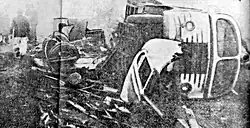| Villa Soldati level crossing disaster | |
|---|---|
 The bus after the impact | |
| Details | |
| Date | June 11, 1962 |
| Location | Villa Soldati, Buenos Aires |
| Country | Argentina |
| Line | Belgrano Sur Line |
| Operator | Ferrocarriles Argentinos |
| Incident type | Level crossing collision |
| Cause | Crossing operator error |
| Statistics | |
| Trains | 1 |
| Deaths | 33[1] |
| Injured | 83 |
The Villa Soldati level crossing disaster occurred on the morning of June 11, 1962 in the Villa Soldati neighborhood of Buenos Aires, when, in dense fog, a train struck a municipal bus carrying schoolchildren.[2][3]
It was one of the worst accidents in the city of Buenos Aires, with the number of fatal victims estimated between 31 and 42.[note 1]
Accident
The accident happened near President Illia Station, where the Belgrano Sur Line train that ran towards the Buenos Aires station crossed Lacarra Street at its junction with Veracruz street.[2] The crossing attendant, believing the crossing to be clear, opened the barriers to allow a truck to cross. The truck was followed by the bus,[5] which was carrying 120 children.[1] The bus driver did not hear the warning bell until it was too late.[3] The impact of the train virtually destroyed the bus[2] and pushed part of it 150 yards down the track.[3]
Dozens of ambulances and a hundred doctors arrived at the scene. The injured were taken to four different hospitals where a shortage of blood and plasma resulted in an appeal for blood donors, to which 1,500 people responded.[5] Many children were taken to Hospital Piñero in a truck driven by the owner of a nearby greengrocer, while others were taken by colectivos 150 and 101 and firetrucks. At the moment of the accident, the visibility was very low due to thick fog, which was a major cause of the accident.[4]
Victims
As a result, 33 people were killed and 83 injured.[1] Other than the bus driver and a female teacher,[5] the dead were children less than 13-years-old.[2] There were no casualties on the train.[5] Most of the children lived at a shanty town on Lacarra street and were less than 6 years old.[4]
A monument was built after the tragedy, marking the scene of the accident.[2]
Notes
References
- 1 2 3 4 EL ANTECEDENTE MAS TRAGICO EN LA CIUDAD FUE EN 1962, CON 33 MUERTOS, Clarín, 14 Sep 2011
- 1 2 3 4 5 Tragedias ferroviarias en Argentina on Foro de Transportes (archived, 11 July 2011)
- 1 2 3 The Times, Jun 12, 1962 page 10
- 1 2 3 Un suceso que enlutó a familias obreras by Miguel Ruffo on Tras Cartón, June 2012
- 1 2 3 4 Railroad Wrecks by Edgar A. Haine, pages 143–144, Publ 1993 ISBN 0-8453-4844-2